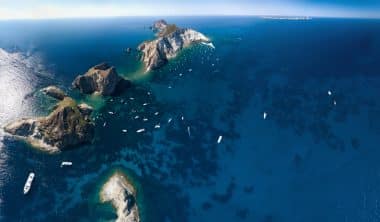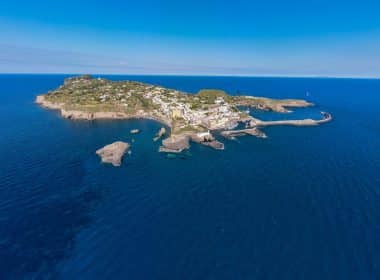South of Rome and northwest of Naples in the Gulf of Gaeta lie six islands known as the Isole Ponziane or Pontine Islands. This archipelago in the Tyrrhenian Sea is named after the largest island, Ponza, which is a true paradise for water sports enthusiasts. Legend has it that the island was named after the Roman governor of Judea, Pontius Pilate, but historians have since refuted this and agree that the name is of Greek origin.
The main island of Ponza
Ponza was originally densely forested when it was first colonized by the Etruscans, who cut down the trees and terraced the land to make it usable for growing fruits and vegetables. Over the years, erosion and development have removed most of the traces of these old terraces, but in some parts of the island there are still dead stumps of the original trees, some of which are over 2.40 m wide. Literary scholars believe that Ponza is the island of “Aeaea”, the home of Circe, the sorceress who turned people into animals depicted in Homer’s “Odyssey”.
Grotta della Maga Circe on the west side of the island, between Spaggia di Chaia di Luna (crescent beach) and Capo Bianco, is said to be the cave where she lived and from which she sent her spells. In fact, the island is famous for its grottoes created by the Etruscans, and the beauty of these caves stands in strange contrast to their names, such as the “Cave of Odysseus of Blood” and the “Serpent Grotto.” Ponza is about ten kilometers long and is the island that attracts the most visitors. There are a few beaches, but the sea line consists mainly of a rocky coastline that is perfect for exploring by boat. The island is also home to an abundance of dive companies and schools that offer equipment for hire and diving lessons.
Although the island is still traditionally Italian and mainstream tourism has not diluted its identity, it is not the place to be if you expect mainly peace and quiet as a tourist. There are many hotels, apartments and bed and breakfast facilities on the island, and of course excellent restaurants serving fresh local dishes. There are many ferry services from mainland Italy that serve Ponza, but since schedules change regularly, it’s best to search for them on the internet to find out the latest departure times and fees.
Zannone
Zannone is an uninhabited island of about one square kilometer and only 10 km from Ponza. It houses the remains of an old Benedictine monastery from the 13th century. The island is under the protection of the forestry authority and is part of the Parco Nazionale del Circeo (Circeo National Park), founded by Benito Mussolini to preserve the last Pontine marshes. It is possible to visit the island by ferry to enjoy the tranquility of this nature reserve.
The Wild Palmarola

Another island with a ferry service from Ponza is Palmarola, an island with a rugged coastline and stunning cliffs. The island has some spectacular grottos and although it is almost uninhabited, there are a handful of restaurants that are open during the summer months, as well as a small holiday accommodation. This island, where Pope Silverus was exiled and where he eventually died in 537, is ideal for photographers and people who love to just relax on the beach or swim in the azure sea.
Ventotene

22 nautical miles southwest of Ponza is Ventotene, an island that had a fair share of exiled Romans. In 2 BC, Emperor Augustus banished his adulterous daughter Julia the Elder here, followed by Caligula’s mother, who was exiled by Emperor Tiberius, and Claudia Octavia, who was sent here by her husband, Emperor Nero, to name a few.
At only 3 km long, Ventotene is perfect for a relaxing getaway. The volcanic landscape has some interesting natural tuff formations that are ideal for keen photographers, and there are enough Roman remains of villas and ancient water and drainage systems to keep history buffs busy for more than just a day: the island has no natural water supply, so water has to be delivered by tanker. In 2009, the discovery of five ancient Roman ships off the coast of Ventotene produced a selection of artifacts, some of which are now on display on the island. Ventotene has a handful of small hotels and holiday accommodations for people who want to spend more than one day there, and during the tourist season there is a selection of open bars and restaurants.
Santo Stefano
The circular island of Santo Stefano measures only 400 meters in diameter and is dominated by a prison originally built by the Bourbons in 1797. The prison consists of 99 cells arranged around a central watchtower. Although the prison was built for 600 prisoners, it usually housed over 800. One of the most notorious inmates was Gaetano Bresci, who murdered King Umberto I. The robber Carmine Crocco, also known as Donatello, who fought alongside Giuseppe Garibaldi, was imprisoned here, as was the journalist and politician Sandro Pertini, who later became the seventh president of the Italian Republic. After the closure of the prison in 1965, the island has remained uninhabited except for the daily influx of tourists.


